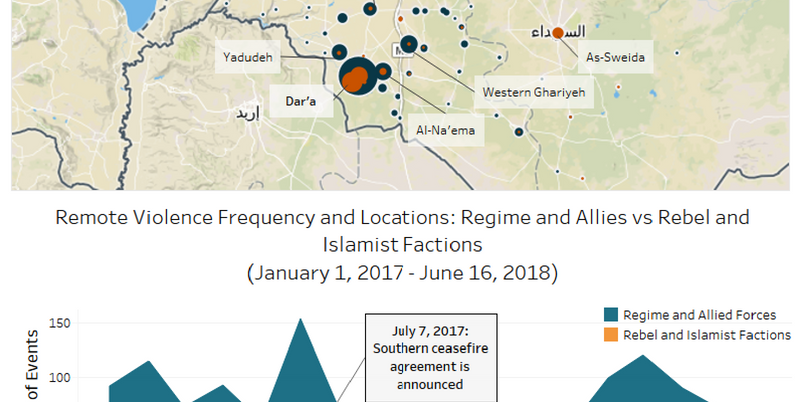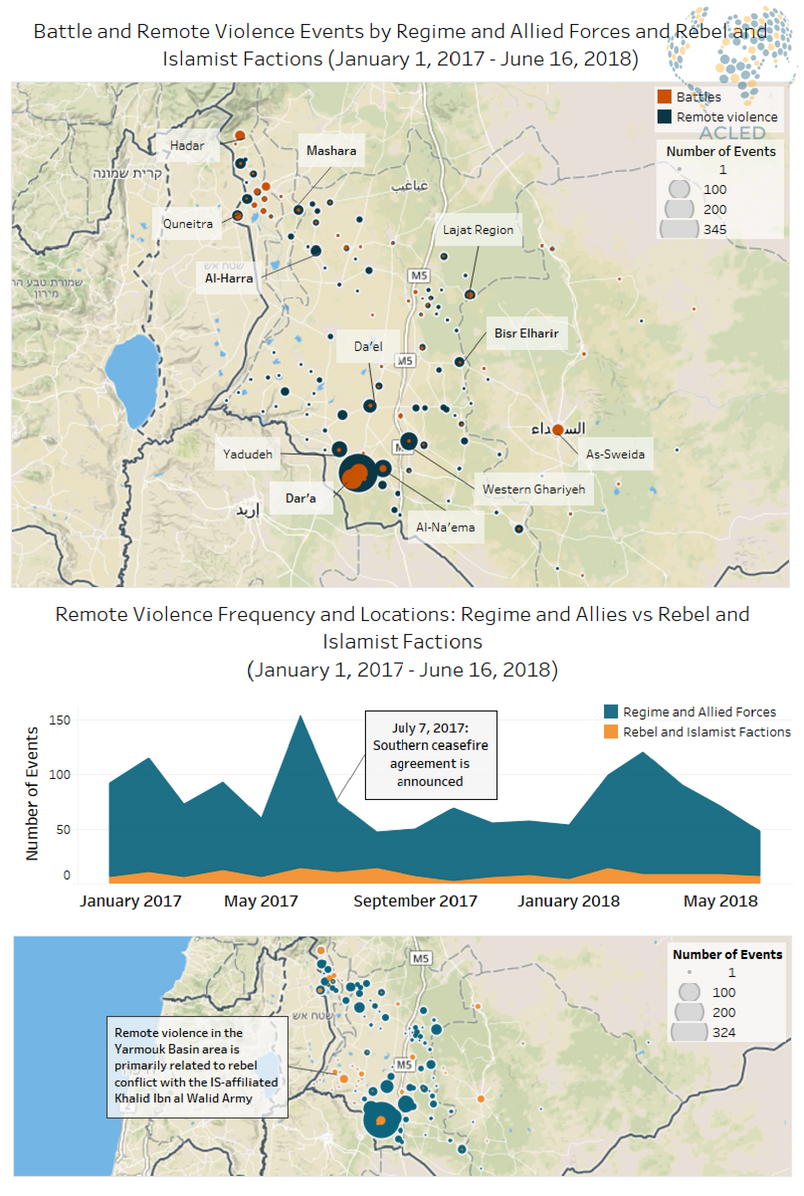Over the past several weeks, in the face of stalled negotiations with rebels and regional and international powers, Syrian regime and allied forces have been amassing along the northern edge of the largely rebel-held ceasefire zone in southwest Syria. This has been a warning of an imminent attack. The ceasefire, originally brokered by Russia, Jordan, and the United States (US), had largely held-until now. In the course of the last week, clashes finally broke out on the eastern and northern edges of the zone, with regime forces ramping up bombardment on rebel-held areas. With Eastern Ghouta and other long-held rebel enclaves now secured, the regime offensive to reclaim the last opposition-held area south of Damascus is officially underway.
The Ceasefire Zone
After a meeting between Presidents Putin and Trump, a ceasefire was announced on July 7, 2017, with the intention of effectively freezing the fighting in Quneitra, Dar’a, and As-Sweida provinces along the Jordanian and Israeli borders. The deal stipulated the creation of a buffer zone to keep Iranian forces and Iranian-backed militia away from the border, and made commitments to eject foreign jihadists from the territory. Jordan was a signatory to the deal, hoping that a freeze in fighting in Syria’s south would stem the flow of refugees. Israel implicitly backed the deal, seeking to keep both rebels and Iranian-backed militias away from its border in the occupied Golan.
Excluding rebel-on-rebel and Islamic State-related violence,[1] and selecting for events in which all primary actors were identified, ACLED data show that ceasefire violations have been committed by regime and allied forces, as well as rebel and Islamist factions. These violations are largely through the use of remote violence rather than direct clashes. However, regime forces have consistently committed more violations, utilizing a disproportionate amount of shelling and airstrikes to pressure rebels in the zone (see below).
The patterns of violence exhibited by the regime in the southern ceasefire zone reflect the broader regime strategy for regaining rebel enclaves elsewhere in Syria. For example, a spike in regime remote violence in the zone (see graph above) during June 2017 –prior to implementation of the ceasefire– mirrors a pattern seen in other areas to pressure rebels into agreements. Additionally, regime reliance on remote violence has been part of a larger strategy of containing rebel and Islamist forces while regime and allied forces were concentrated elsewhere. This has limited rebel capacity in preparation for an eventual regime offensive. These strategies have been previously employed in Rural Damascus, Hama, Homs, and Aleppo. When battles have occurred in the south, they were likely an extension of this strategy, harassing and distracting the factions while testing the strength of their defenses.
Prospects
As ACLED data demonstrate, the majority of regime ceasefire violations have taken place in the more populated areas of southern Dar’a and the middle sector of Quneitra. Conversely, the recently-commenced regime offensive will likely focus on securing less densely-populated, but strategic areas, in the north of Dar’a, such as Lajat region. The regime will then proceed with a divide-and-conquer strategy[2] to section off rebel presence into smaller enclaves, leaving the provincial capital of Dar’a for the end of the campaign.
If Russia provides critical air support, then a regime victory is likely to only take a matter of weeks. Relatedly, the US has made clear to southern rebels that it will not intervene against the regime offensive and, so long as Iranian-backed militias stay out of the fighting, Israel is also likely to remain on the sidelines. Either way, the offensive is certain to be bloody, with regime forces preferring to bombard opposition-held areas to induce high levels of civilian casualties in order to force rebel capitulation.
[1] These interactions were not included in the ceasefire.
[2]This strategy was most recently employed by the regime in its offensive to retake the Eastern Ghouta. Separating the most strategic rebel cities and towns from one another allowed the regime to more quickly break resistance and force rebels into accepting surrender and evacuation deals.
AnalysisCivilians At RiskFocus On MilitiasInfographics archiveIslamic StateIslamist ViolenceMiddle EastPolitical StabilityPro-Government MilitiasRemote ViolenceViolence Against Civilians







